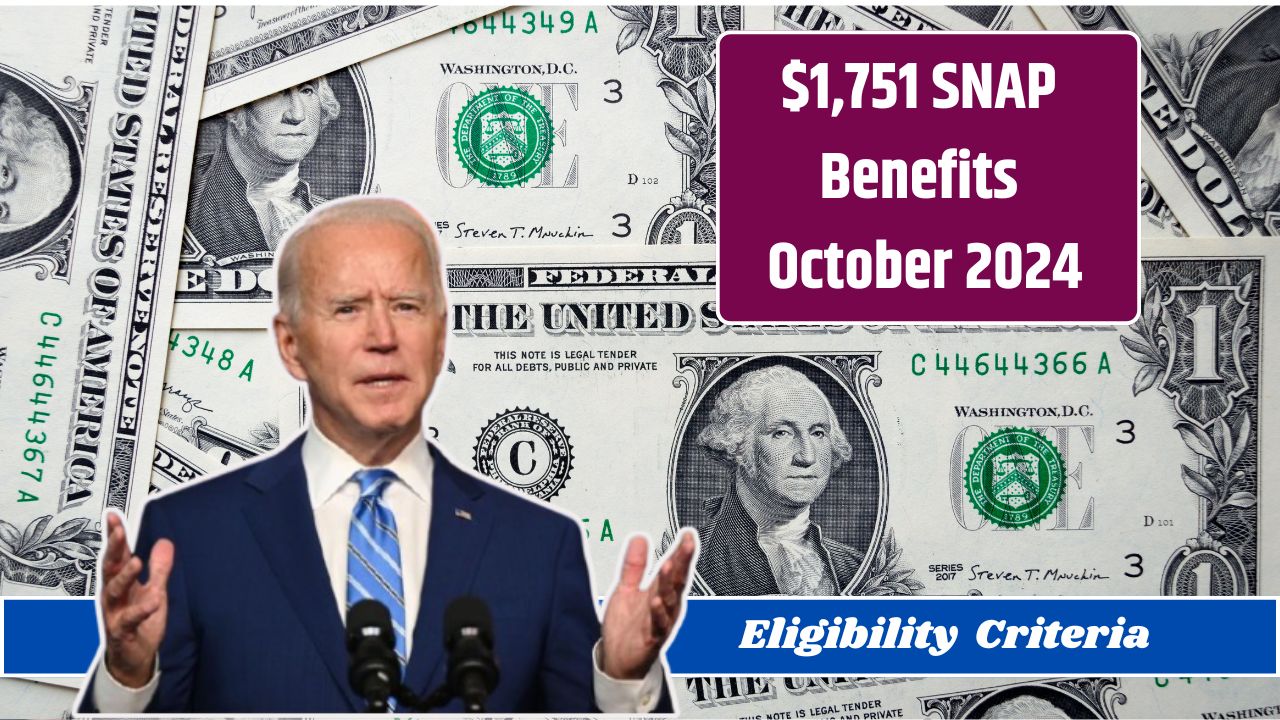The Supplemental Nutrition Assistance Program (SNAP), formerly known as food stamps,
remains a key source of support for millions of low-income families across the U.S. As October 2024 begins, many are eager to learn about updated benefit amounts,
eligibility criteria, and how to claim the maximum benefit of $1,751. In this article, we’ll explore the details of the SNAP program, its significance, and provide helpful tips on how to maximize benefits.
What Is SNAP?
Administered by the U.S. Department of Agriculture (USDA), SNAP provides financial aid to eligible households to purchase nutritious food.
This program plays a crucial role in combating hunger and promoting healthier eating habits, especially amid rising grocery costs due to inflation.
How SNAP Works
SNAP benefits are provided through an Electronic Benefit Transfer (EBT) card, which functions like a debit card.
Beneficiaries can use the card at authorized retailers, including grocery stores and farmers’ markets, to buy eligible food items such as:
- Fruits and vegetables
- Dairy products
- Meat and poultry
- Bread and cereals
- Other staple foods
However, SNAP benefits cannot be used to purchase non-food items like household supplies, pet food, or alcohol.
October 2024 Benefit Amounts
For October 2024, eligible households with eight or more members can receive a maximum benefit of $1,751.
The actual benefit amount varies based on household size, income levels, and annual cost-of-living adjustments (COLA). Below is a general breakdown of maximum benefits by household size:
| Household Size | Maximum Monthly Benefit (October 2024) |
|---|---|
| 1 | $291 |
| 2 | $535 |
| 3 | $766 |
| 4 | $973 |
| 5 | $1,155 |
| 6 | $1,386 |
| 7 | $1,532 |
| 8+ | $1,751 |
SNAP Eligibility Requirements
To qualify for SNAP, households must meet certain income and resource criteria set by the USDA.
These are designed to ensure that help reaches the most in need. Below are the key eligibility factors:
Income Limits:
- 100% of the Federal Poverty Level: A family of eight must have a gross monthly income of $4,214 or less.
- 200% of the Federal Poverty Level: The upper income limit is $8,428 for a family of eight.
Resource Limits:
- General Households: Must not exceed $2,750 in countable assets (cash, savings, etc.).
- Households with Elderly/Disabled Members: Can have up to $4,250 in countable assets.
These income and resource limits may change periodically, so applicants should always verify the latest details on the USDA’s official website.
How to Apply for SNAP Benefits
Applying for SNAP involves a straightforward process:
- Interview: In some cases, applicants may be required to attend an interview, either in person or by phone, to discuss their situation further.
- Complete the Application: Fill out the application form available on the USDA’s website. Provide your personal information and document your household income.
- Approval and EBT Card: Once approved, you will receive an EBT card loaded with your monthly benefits. Payment schedules may vary by state, so check with your local SNAP office for specific distribution dates.
- Recertification: Beneficiaries need to recertify periodically to continue receiving benefits without interruption.
For more details on how to apply, visit the USDA’s official site where step-by-step instructions are provided.
Maximizing Your SNAP Benefits
To make the most of your SNAP benefits, careful planning and smart shopping strategies are essential. Here are some practical tips:
- Shop at Discount Stores: Retailers like Walmart, ALDI, and Dollar General accept SNAP benefits and offer lower prices.
- Use Coupons and Loyalty Programs: Many stores have coupons and rewards programs that can help you save even more.
- Buy in Bulk: Non-perishable items like canned goods and grains are often cheaper in larger quantities.
- Choose Seasonal Produce: Seasonal fruits and vegetables are not only cheaper but often more nutritious.
- Meal Planning: Planning meals in advance helps reduce food waste and makes shopping more efficient.
- Compare Prices: Check prices at different stores to ensure you’re getting the best deal.
- Opt for Generic Brands: Store-brand items tend to be cheaper than name brands but offer similar nutritional value.
- Utilize Farmers’ Markets: Many farmers’ markets accept EBT cards and offer fresh, local produce at competitive prices.
The Role of SNAP in Reducing Food Insecurity
SNAP is vital in reducing food insecurity in the U.S., providing much-needed assistance to families and individuals struggling to afford nutritious food. The program helps:
Read Also- Eight Rare Dimes and a Rare Bicentennial Quarter – Each Worth $70 Million, Still in Circulation
- Alleviate hunger and malnutrition
- Improve public health outcomes
- Support local economies by increasing food purchasing power
- Ease financial stress on households
As inflation continues to drive up food costs, the importance of SNAP benefits in maintaining access to essential nutrition cannot be overstated.
Staying Informed
To ensure you receive the most current SNAP benefits and information, it’s crucial to stay updated. Here are a few ways to do so:
- Check the USDA’s website regularly for program updates.
- Sign up for notifications from your local SNAP office.
- Follow credible news outlets that cover changes in public assistance programs.
- Attend local community workshops on SNAP benefits.
By staying informed, you can make sure you are receiving the benefits you’re entitled to.
The SNAP program remains a lifeline for millions of low-income households, ensuring access to nutritious food during times of need. With potential benefits up to $1,751 for large families, it’s important for recipients to understand the eligibility criteria and how to maximize their benefits through smart shopping strategies.
FAQs:
Who qualifies for the maximum SNAP benefit?
Households with eight or more members and meeting income requirements can qualify for the maximum benefit of $1,751.
What is the income limit for SNAP in October 2024?
For a family of eight, the gross monthly income limit is $4,214 (100% of the poverty line) and $8,428 (200%).
Can I use SNAP benefits to buy non-food items?
No, SNAP benefits cannot be used for non-food items like cleaning supplies, pet food, or alcohol.











